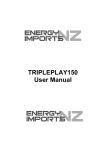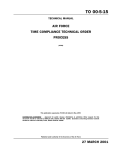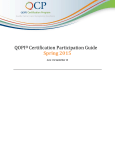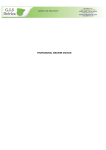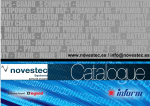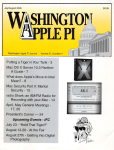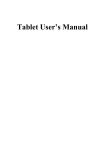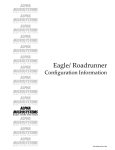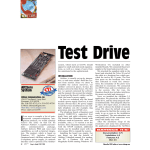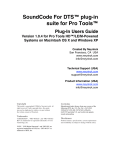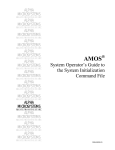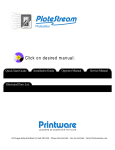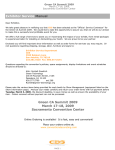Download Electronic message sorting and notification system
Transcript
US006396513B1
(12) United States Patent
(10) Patent N0.:
(45) Date of Patent:
Helfman et al.
US 6,396,513 B1
May 28, 2002
Applied Voice Technology, “Applied Voice Technology
(54) ELECTRONIC MESSAGE SORTING AND
(75) Inventors: Jonathan Isaac Helfman, Gillette, NJ
Announces Proprietary Digital Integration BetWeen CallX
press3 and Northern Telecom Northstar Key Systems (NeWs
Release)”, 441 Words (reprinted as pp. 1—2),Aug. 18, 1992.*
(US); Charles Lee Isbell, Cambridge,
MA (US)
Anonymous, “Fruits of LANned Phones: Will You Ever Go
Back to Your PBX?”, Teleconnect, v. 12, n. 3, pp. 44—51,
NOTIFICATION SYSTEM
Mar. 1994.*
(73) Assignee: AT&T Corp., NeW York, NY (US)
(*)
Notice:
Business Wire, “Applied Voice Tech: AVT Opens CallX
press3 to Third—party Developers; CallXpress3 Access SDK
Voice—Mail—Enables Applications”, Business Editors, 565
Words (reprinted as pp. 1—2), Jun, 22, 1994.*
Business Wire, “Applied Voice Tech: AVT Ships NeW
ROLM CBX 8004 Integration Offering Signi?cant Com
petative Advantages”, Business Editors, 461 Words
Subject to any disclaimer, the term of this
patent is extended or adjusted under 35
U.S.C. 154(b) by 0 days.
(21) Appl. No.: 08/645,740
(22) Filed:
May 14, 1996
(51)
(52)
(58)
(reprinted as pp. 1—2), Jul. 14, 1994.*
Business Wire, “Applied Voice Tech: AVT Products Help
Arizona School District Develop ‘Classroom Information
Line’”, Business Editors, 519 Words (reprinted as pp. 1—2),
Int. Cl.7 ............................................ .. G06F 15/173
US. Cl. ...................... .. 345/752; 709/206; 709/207
Field of Search ..................... .. 395/200.34, 200.37;
Aug. 8, 1994.*
345/347, 340, 356, 752; 379/88; 709/206,
(List continued on next page.)
207
Primary Examiner—Joseph H. Feild
(56)
Assistant Examiner—Jeffrey A. Rossi
References Cited
(57)
U.S. PATENT DOCUMENTS
5,283,818
5,400,393
5,557,659
5,627,764
A
A
A
A
*
*
*
*
5,630,042 A *
2/1994
3/1995
9/1996
5/1997
5/1997 McIntosh et a1.
5,694,616 A
* 12/1997 Johnson et a1.
709/207
5,699,089 A
* 12/1997 Murray ....... ..
345/823
Heiny
Wherein incoming mail is automatically sorted into
mailboxes, based on criteria de?ned by the user. In addition,
the user can rank the mailboxes in order of importance, and
the mailboxes are presented to the user in the order of rank.
345/744
* 11/1997 Finnigan ..... ..
5,778,356
The invention concerns an improved electronic mail system,
Klausner et a1. ....... .. 379/8825
Knuth et a1. ........... .. 379/8827
Hyde-Thompson .... .. 379/8813
SchutZman et a1. ....... .. 709/207
5,687,220 A
379/8822
A
*
7/1998
5,796,394 A
5,877,746 A
*
*
8/1998 Wicks et a1. .............. .. 709/206
3/1999 Parks et a1. ............... .. 345/835
.. ... ... ..
. . . . . ..
The user can also establish thresholds for any measurable
characteristic of a mailbox. For example, one measurable
characteristic may be the total number of unread messages.
The user may choose to be informed When the total number
of unread messages exceeds a threshold. If the threshold is
707/2
set to ten, for example, then, When the eleventh message is
received, the system triggers an alarm, notifying the user.
The system also includes an interface Which displays mul
tiple Windows to the user simultaneously, shoWing not only
FOREIGN PATENT DOCUMENTS
JP
6-133043
*
5/1994
ABSTRACT
.......... .. H04M/3/42
OTHER PUBLICATIONS
the contents of mail messages, but also other information
about the user’s mail, such as the ranking of the mailboxes
Applied Voice Technology, Inc. “Uni?ed Messaging Solu
tions.” Dallas: Computer Telephony Expo, Mar. 7, 1995.*
Hasting, Bryan. “The Complete PC Offers Voice, Data, and
and the criteria for triggering alarms.
Fax Messaging on Your PC.” PC World.p. 88, May 1993.*
7 Claims, 8 Drawing Sheets
DISPLAY 4 WINDOWSI
1) CURRENT MESSAGE
2) HEADERS OF
CURRENT MAILBOX
3) CHRONO LOG
4) SUMMARY OF
CHECK CONTROL FILE
TO SEE WHETHER
ANOTHER ISHMAIL IS RUNNING
{
FETCH E-MAIL FROM
SPOOLB?
1
67
D63
MAILBOXES
1
CHECK FOR CURSOR
MOVEMENT. CHANGE
SORT MAIL INTO MAILBOXES
ACCORDING TO FILTERS
MAILBOX AND MESSAGE,
\\
As REQUESTED.
as
68
RANK AND FRIORITIZE
i
MAILBOXES
ALLow USER TO SET ALARMS
CHECK ALARM CONDITIONS
7
66A
75 ?
ALLOW USER TO ARCHIVE
SELECTED MESSAGE
3J7
AND RAISE ALARMS. As
APPROPRIATE.
US 6,396,513 B1
Page 2
OTHER PUBLICATIONS
Wolf, Jim et al., “An Open WindoWs on Voice and Fax”, PC
Hespe, Mary B., Universal InboX: Where PC, Voice Mail
Converge (short takes), Computer Reseller NeWs, n. 592, p.
59 (reprinted as pp. 1—2), Aug. 22, 1994.*
Applied Voice Technology, “Voice Processing: Applied
Voice Technologiy’s Automated Agent Paves the Way for
More Sophisticated Applications of Interactive Voice
Response (press release)”, Edge, v.10, n. 352, p. 18
(reprinted as pp. 1—2), Apr. 13, 1995.*
Kalman, Steve, “CTI and the Marketplace. (Integrated Tech
nology’s CompuPhone, Rochell Communications’ Caller
Pro?le
and
Wild?re
Communications’
Wild?re
MagaZine Network Edition, v. 13, n. 17, pp. NE44—48
(reprinted as pp. 1—3), Oct. 11, 1994.*
Kalman, Steve, “NetWorking on the Phones”, Local Area
NetWork (LAN) MagaZine, pp. 177—182 (reprinted as pp.
1—6), Oct. 1995.*
Anonymous, “Call Processing App Gen Roundup”, Tele
connect, v. 13, n. 12, pp. 56—64 (reprinted as 1—11), Dec.
1995.*
Computer—telephony Products)”, Network VAR, v.3, n.9,
pp. 49—53 (reprinted as pp. 1—5), Sep. 1995.*
Business Wire, “Applied Voice Tech: Applied Voice Tech
nology Adds Call Center Module to Automated Agent
Version 3.0”, Business Editors, 778 Words, (reprinted as pp.
Business Wire, “Applied Voice Technology Announces
Major NeW Release of Interactive Voice Response (IVR)
Platform; Automated Agent Supports any ODBC—complient
1—2), Sep. 20, 1995.*
Database Management System”, p. 3120120 (reprinted as
pp. 1—2), Mar. 12, 1996.*
Business Wire, “Applied Voice Tech 2: Applied Voice Tech
nology to Demonstrate TWo NeW Computer—Telephony
Products for Microsoft Users”, Business Editors, 771 Words,
(reprinted as pp. 1—2), Sep. 20, 1995.*
* cited by examiner
U.S. Patent
May 28,2002
Sheet 1 of 8
US 6,396,513 B1
5
1.“_:|"a
U.s.m
m
nw.
OZBZE
P.
m
"swzmj<
mn.
Q.
n
u
6
m
m
n596m :
m
2m.
m
P
V2;
2
#580
H5% m
w on
é%
"
wmm
_z a
\H
.3.m
:mwmE
m
"
M
m
m
m.
mm .
m
m
m
<~
39:: m
m,
m
EwmwEmm
m
ozw o<wmwz
m
s"..u5.
-1.
u_._0.
m
n3652:U
m
n
“
n
<@
“a
_
m
P
U.S. Patent
May 28,2002
Sheet 7 of 8
US 6,396,513 B1
@EE@
mwo< z .EwmM
Ilmm
Ilu-
l-
US 6,396,513 B1
1
2
ELECTRONIC MESSAGE SORTING AND
NOTIFICATION SYSTEM
1, runs on a server 6. This program Will be termed an “e-mail
program” herein. This type of program is commercially
BACKGROUND OF THE INVENTION
available. One such program is that marketed under the
name “SENDMAIL”, and available from Universty of
California, located in Berkeley, Calif.
Acommon type of electronic mail (“e-mail”) system takes
The e-mail program 3 handles tasks such as
the form of one, or more, computer programs running on a
server, Which also runs other application programs, such as
(1) accepting outgoing e-mail messages from users;
Word-processing, spreadsheet, high-level language
compilers, etc.
10
When a user logs onto the server, to use one of the
application programs, the e-mail system may examine the
queue of e-mail messages held in the user’s mailbox. If
messages are found stored in the mailbox, the system may
notify the user, as by a notice stating, “You have mail.”
Alternately, if neW messages are found, Which the user has
not accessed previously, the notice may instead read, “You
have NEW mail.”
When the user calls for the mail, the system presents a list
of the messages stored in the mailbox on the user’s display
(3) accepting incoming e-mail messages from the distri
bution service, for its oWn users;
15
for its users; and
Another program, termed “Ishmail” herein and indicated
by phantom boxes 9, runs on one or more of the computers
12 served by the server 6. The Ishmail program can be
classi?ed as a type of e-mail reading system.
Use of the Ishmail program is optional on the computers
and so on. When the user selects a message from the list, the
12, as indicated by the absence (signi?ed by the “X”) of a
25
For a person receiving large quantities of e-mail, this
procedure can be cumbersome. The person is required to 1)
select a message from the list, 2) jump, in effect, to a neW
screen, Which shoWs the selected message, 3) jump to the list
again, to select another message, and repeat the previous
computer’s normal interaction With the e-mail program 3
In order to describe the major features of the Ishmail
program, it is desirable to ?rst examine the basic structure of
e-mail messages generally. An electronic mail message can
be vieWed as a packet of digital data, Which is divided into
Other types of e-mail systems eliminate some of these
selected message in another region. HoWever, even this
improvement is seen as lacking in optimality for intensive
?elds. FIG. 2 illustrates an example.
35
SUMMARY OF THE INVENTION
If data is appended to the message, such as a ?le 21, the
appended data can be treated as another ?eld. In addition, a
summary, or abstract, 23 may accompany the message, and
represent a brief description of the contents of the message.
In one form of the invention, a recipient of e-mail
messages creates multiple mailboxes, into Which incoming
mail is automatically sorted, based on criteria established by
the user. The user can de?ne conditions for each mailbox
The summary is created by the sender of the message. The
45
BRIEF DESCRIPTION OF THE DRAWINGS
In the general case, other ?elds are possible. In a particu
?eld.
The e-mail program 3 in FIG. 1 stores the messages in a
“spool” (not shoWn). When a user fetches e-mail, using a
computer 12A in FIG. 1 Which is equipped With the Ishmail
program, the Ishmail program doWnloads the user’s mes
sages Which are spooled in the server 6, via data link 25.
FIG. 4 is a How chart illustrating selected steps under
55
After doWnloading, the data packets corresponding to the
user’s messages become available locally at the user’s
computer 12A, for the Ishmail program to process. A sig
ni?cant processing feature of the invention alloWs users to
establish, at their local computers 12, multiple different
in response to user activity.
mailboxes, having different names. The Ishmail program
FIG. 7 illustrates a How chart representing logic under
taken by one form of the invention.
DETAILED DESCRIPTION OF THE
INVENTION
summary can be treated as another ?eld, and additional
?elds can be de?ned.
lar case, the entire message itself can be considered a single
FIG. 1 illustrates a server 6 Which provides electronic
mail service to remote computers 12.
FIG. 2 illustrates an exemplary electronic mail message.
FIG. 3 illustrates a display used as an interface by one
form of the invention.
taken by the invention.
FIG. 5 illustrates prioritiZing of mailboxes, and ranking
criteria, for ranking MAILBOXES.
FIG. 6 illustrates dynamic re-ordering of MAILBOXES,
The content 15 of the message represents one ?eld. The
header 18 represents another ?eld. The header 18 can be
divided into sub-?elds. These sub-?elds include the identity
18A of the sender of the message, the destination 18B, the
distribution list 18C (the symbol “CC” means “carbon
copy”), and the subject matter 18D of the message.
users of e-mail.
Which trigger alarms When the conditions are met.
phantom box 9 on computer 12C. The presence or absence
of an Ishmail program in a computer 12 does not affect the
running on the server 6.
seteps.
cumbersome features, by maintaining the list of the mes
sages in one region of the display screen, and displaying the
(4) holding, or “spooling,” the incoming e-mail messages
(5) delivering the spooled e-mail messages to its users,
upon request.
screen, together With selected information about each, such
as the identity of the sender, the date and time of dispatch,
system erases the list from the screen, and displays the
selected message instead.
(2) delivering the outgoing e-mail messages to a distri
bution service, for delivery to another server, contain
ing another e-mail program, Which receives and holds
the messages for the message recipients;
sorts the messages into these mailboxes, based on informa
tion contained in the various ?elds of the messages.
In addition, the Ishmail program alloWs the user to rank
the mailboxes, and the ranking changes dynamically, based
65
on the user’s interaction With the mail messages, and upon
In one form of the invention, an electronic mail transfer
characteristics of neW, incoming mail. The sorting and
and-delivery program, indicated by phantom box 3 in FIG.
ranking procedures are perhaps best illustrated by example.
US 6,396,513 B1
3
4
EXAMPLE
are indicated, With “ALARMS RINGING” as the highest
rank and “NO MESSAGES” as the loWest rank.
The invention groups each mailbox into one of the ranks.
Sorting of Mail
In this Example, the user Wishes to collect all e-mail
messages originating from the user’s supervisor in a single
Then, Within each rank, the invention lists the mailboxes in
mailbox, and all other messages in another mailbox. 5 order of priority. FIG. 6 provides an example.
On the left side of FIG. 6, mailboxes 1A and 2A are
Accordingly, the user establishes tWo different mailboxes
Within the user’s local computer 9, one of Which is entitled
“Boss,” and the other of Which is entitled “General.” The
grouped into the “ALARMS RINGING” rank. Then, since
mailbox 1A has a higher priority than mailbox 2A, mailbox
details of establishing these mailboxes are explained in
1A is listed ?rst Within this rank. Mailboxes 2B and 3A are
APPENDIX A, Which is a copy of a user’s manual for
grouped into the “UNREAD MESSAGES PRESENT” rank.
Then, since mailbox 2B has a higher priority than mailbox
3A, mailbox 2B is listed ?rst Within this rank, and so on.
After prioritiZing and ranking, When the invention dis
plays the list of these MAILBOXES to the user, the inven
tion presents the list in the exemplary order shoWn on the left
side of FIG. 6. That is, mailbox 1A is listed ?rst, mailbox 2A
next, and mailbox 3B last.
NoW, the user may take action With respect to the list. For
example, the user may read the messages in mailbox 3A.
After the user reads these messages, the invention changes
the rank of mailbox 3A, as indicated by arroW 98, because
that mailbox no longer contains unread messages. NoW, the
presentation of the user’s list of mailboxes is made accord
ing to the ranking shoWn on the right side of FIG. 6.
The ranks identi?ed by dashed box 95 in FIG. 5 are based
on pre-de?ned criteria, namely, Whether a given mailbox
contains (1) unread messages, (2) messages, or (3) no
operating the Ishmail program. HoWever, the general steps
in establishing a mailbox are the folloWing:
(1) The user assigns a name to the mailboxes (“Boss” and
“General” in this example).
(2) The user speci?es the ?elds in the incoming messages
Which are to be searched, for sorting the messages into their
respective mailboxes. For the “Boss” mailbox, the ?eld
identifying the sender, namely, sub-?eld 18A in FIG. 2, is
speci?ed. For the “General” mailbox, no ?eld is speci?ed,
because all messsages Which are not sorted into the “Boss”
mailbox are sorted into the “General” mailbox, by default.
(3) The user speci?es a search string, Which is the
sequence of characters sought in the ?elds speci?ed in step
2. (In this example, the search string indicates supervisor’s
name.)
After the messages are doWnloaded into the user’s local
computer 12A in FIG. 1, the Ishmail program 9 examines the
?eld 18A in FIG. 2 of all the messages, in pursuit of the
messages. HoWever, the highest rank, “ALARMS
RINGING,” is not based on pre-de?ned criteria, but on
criteria under control of the user.
That is, the user establishes conditions under Which
alarms are triggered. When an alarm is triggered, the cor
speci?ed search string, namely, the name of the supervisor.
When the supervisor’s name is found in sub-?eld 18A of any
message, that message is sorted into the mailbox labeled
“Boss.” The remaining messages are sorted into the “Gen
eral” mailbox.
responding mailbox is grouped into this highest rank. Sev
eral examples of alarm-triggering conditions are the follow
ing:
This example illustrates four features of the invention.
One: the user is able to create multiple mailboxes, and to
assign a different name to each.
a) As one type of condition, the user can set a threshold
35
TWo: the user generates a search string, or ?lter, and
assigns the ?lter to a speci?c ?eld Within the messages.
exemplary parameters:
i) total messages contained in the mailbox,
ii) number of unread messages in the mailbox,
Three: the Ishmail program searches the speci?ed ?elds,
for the speci?ed search string, and, When a match is found,
stores the message having the matching string in the mailbox
assigned to the ?lter. Signi?cantly, if the same search string
iii) number of messages to Which the user has not
responded in the mailbox,
iv) total characters contained in the mailbox,
V) date of oldest unread message in the mailbox, and
exists in another ?eld of the message, that same search string
is ignored. The search is limited to the speci?ed ?eld. For
purposes of searching, the entire message may be considered
a ?eld.
so on.
When a parameter for a mailbox exceeds the respective
45
Four: the Ishmail program does not interfere With normal
interaction betWeen a computer and the e-mail program 3 in
FIG. 1. That is, computer 12C can interact With the e-mail
program 3, as usual, using a commercially available mail
reader program, such as one supplied by the developer of the
number for a mailbox, based on any of the folloWing
50
threshold, an alarm is triggered.
b) As another type of condition, the user can, in effect,
specify that, When a particular character string is found
in a particular ?eld of a message, an alarm is triggered.
To implement this condition, the user Would take tWo
steps: (1) create a mailbox into Which messages are
sorted if they contain the character string, and (2) set
e-mail program 3. Further, computer 12A, Which is equipped
With Ishmail, is not required to invoke Ishmail, but can also
the threshold for this mailbox to Zero, so that an alarm
interact With the e-mail program 3, in the same manner as
is triggered Whenever a message reaches this mailbox.
computer 12C, if equipped With ANOTHER a mail reader
c) In the general case, as explained in Appendices A and
B, the condition can be set by any measurable, search
program.
PrioritiZing and Ranking
In addition to these features, the Ishmail program alloWs
prioritiZing and ranking of the mailboxes. When the user
creates mailboxes initially, the user assigns a priority to each
mailbox. In the preferred embodiment, MULTIPLE priori
able characteristic of the e-mail messages contained in
the mailbox.
Interface
It is expected that a user Who receives a large volume of
m 0 e-mail Will create multiple mailboxes, and that, as time
ties are available: such as ?rst (highest), second, and third.
FIG. 5 illustrates six mailboxes, on the left side, and their
progresses, they Will accumulate a signi?cant supply of
assigned priorities, indicated by numbers. Mailboxes 1A and
messages, the invention provides the interface shoWn in
1B are assigned ?rst priority. Mailboxes 2A and 2B are
assigned second priority, and so on.
In addition, the invention establishes a ranking system,
indicated on the right side of FIG. 5. Four ranking criteria 90
messages. In order to alloW the user to manipulate the
FIG. 3.
65
The interface contains four WindoWs. WindoW 30 displays
the current message selected by the user. This message is
analogous to the message shoWn in FIG. 2.
US 6,396,513 B1
6
5
Window 33 contains the headers of the messages stored in
the remaining tWo WindoWs in response, by displaying, in
the mailbox currently selected. (A mailbox is selected in
WindoW 40, and the selection procedure is discussed beloW.)
WindoW 33, a list of messages contained in the selected
FIG. 2 illustrates an exemplary header 18. In WindoW 33, the
entries of column 39 correspond to the entries of ?eld 18D
in FIG. 2, the subject ?eld. If no subject ?eld exists, as When
the sender of the message did not create a subject ?eld, then
the ?rst line of the message is treated as the subject ?eld.
In WindoW 33, the entries of column 36 correspond either
to (a) the entries of ?eld 18A in FIG. 2, if the message Was
received from a remote location, or (b) to the entries of ?eld
18B, if the message Was sent by the user. The entries in
column 36 in FIG. 3 designated by the Word “to” indicate
mailbox, and, in WindoW 30, the full text of the ?rst unread
message on the list.
Additional Considerations
1. “Mailbox” de?nitions. The term “mailbox” refers to a
virtual entity. No physical “boxes” exist, nor does paper
“mail” exist. One de?nition of “electronic mailbox” is a
collection of messages, usually implemented as a ?le,
10
mailboxes containing outgoing messages. HoWever, outgo
ing and incoming mailboxes can both be sorted into the same
mailbox if desired.
The user can highlight a message header in WindoW 33 by
moving a cursor 39 to the desired message, causing the
message to be highlighted by bar 41. The user can then select
15
Another de?nition is a storage location, capable of receiv
ing and storing concatenations of messages, Which is
assigned to a speci?c individual, and Which is thus distin
guishable from other similar storage locations.
2. Checking for running of second program. As discussed
in Appendix B in greater detail, upon initiation of an Ishmail
running another Ishmail program. This checking is done
because it is considered undesirable to run tWo programs, or
processes, Which maintain access to common ?les.
the highlighted message, as by clicking the pointing device
For example, the user may have run the Ishmail program
at the user’s office, but have left the of?ce Without termi
nating the program. It is possible that the “of?ce” Ishmail
program holds an e-mail message Which has been modi?ed,
25 or has instructions to delete an e-mail message. If the user
generates, or modi?es, the same e-mail message using an
Ishmail program at the user’s home, it is possible that the
“office” Ishmail program may later unexpectedly impose its
modi?cations, or deletion, upon the e-mail message.
contained in the currently selected mailbox, together With
The invention prevents this problem by establishing a
selected data about the messages. WindoW 44 lists the
mailboxes contained Within the system, Which Were de?ned
by the user, and lists selected data about them.
WindoW 40 contains (1) a column 47 indicating the names
control ?le When Ishmail is initiated. The control ?le can be
vieWed as a ?ag Which is set, indicating that an Ishmail
program has been launched. Using a control ?le has the
advantage that it is detectable by the second Ishmail pro
of the mailboxes; (2) a column 49 indicating both the
number of unread messages, and the total number of
messages.
program, the invention checks Whether the initiating user is
used to move the cursor 39. Upon selection in WindoW 33,
the invention displays the selected message in WindoW 30.
Thus, header-WindoW 33 represents a table of contents of the
currently selected mailbox, and alloWs the user to select, and
display in WindoW 30, any message listed in the table.
WindoW 40 lists the existing mailboxes, and selected data
about them. This list is someWhat analogous to that of
header-WindoW 33. Header-Window 33 lists the messages
capable of containing a concatenation of one or more
35
gram.
The “home” Ishmail program notices control ?le, and
inquires Whether the user Wishes to take control. If not, then
messages, Within each mailbox; (3) a column 52 indicating
the time/date stamp of the oldest unread message; (4) tWo
columns labeled 55.
Within the latter, the left column refers to the maximum
the “home” Ismail program exits, leaving the messages
late in the mailbox, before an alarm is triggered. One Way to
undisturbed.
If the user does Wish to take control, the “of?ce” Ishmail
program is ordered to exit, and takes all actions as if
signal an alarm is to cause a speci?c icon to appear on the
manually terminated.
number of unread messages Which are alloWed to accumu
user’s computer display, such as one stating “The ‘Boss’
mailbox is noW full.” Of course, if the threshold is Zero, then
the alarm is triggered Whenever a neW message is received.
The user speci?es the threshold in the manner indicated in
APPENDIX A.
In a preferred embodiment, in FIG. 3, WindoW 40, a
textual character, such as an asterisk or “plus sign,” is placed
into the column labeled “Alarms,” adjacent the name of a
3. Sorting of current messages. During operation of
45
4. Sorting of outgoing mail. The Ishmail program offers
the option of alloWing the user to treat the user’s oWn
outgoing mail as incoming mail. That is, the outgoing mail
is sorted, using the pre-established ?lters, into the pre
mailbox, to signal an alarm’s having been triggered for that
mailbox.
de?ned mailboxes, Which are ranked and prioritiZed, as
described above.
The right column represents another type of threshold,
namely, the age in days of the oldest unread message. When
the oldest unread message reaches this age, another alarm is
Ishmail by a user, neW messages may arrive in the spool of
the e-mail program 3 in FIG. 1. The Ishmail program checks
for neW messages, doWnloads them, and then sorts them into
the proper mailboxes.
55
triggered.
5. Searching. The invention provides tWo types of
searching, upon tWo different types of entities. The ?rst type
of searching examines the ?elds of the messages, and sorts
WindoW 50 contains a chronological log of incoming
the messages into mailboxes, based on ?eld content, as
messages. The messages are listed in order of their arrival
described above. The second type searches the messages,
times. Each entry (or roW) contains the time/date stamp
once classi?ed in a mailbox, and can be used to trigger
time, the mailbox to Which the message has been assigned,
alarms.
The invention can search for any detectable characteristic
the origin of the message (or the destination, if sent by the
user), and the subject of the message (or the ?rst line of the
message, if there is no subject). The origin and the subject
of a character sequence. Some exemplary searches are the
folloWing:
correspond to the sub ?elds 18A and 18D in FIG. 2,
respectively.
A. A search for a particular name, such as “Wilson,” in a
The user can select any line corresponding to a mailbox
particular ?eld, or in all ?elds.
B. A search for a particular sequence of characters, such
in either of WindoWs 40 or 50, and the invention Will update
as “James A. Wilson,” in a particular ?eld, or in all ?elds.
65
US 6,396,513 B1
8
7
In addition, as indicated by block 165, the voice mail
C. Asearch for a particular sequence of characters, Which
includes “Wild cards.” For example, if the character “?”
system alloWs (1) the oWner to rank the names in the
telephone directory, thereby associating a priority With each
eXpected caller; (2) the oWner to specify a key number,
represents a Wild card, a search can be made for the name
“James Wilson,” irrespective of the middle initial, by the
search string “James ‘2? Wilson.”
D. Boolean key-Word searching can be done. For
Which indicates hoW many messages are to be played in a
eXample, a search can be done for the Word “James,” but
only if it occurs Within ten Words, preceding or following,
the Word “Wilson.”
E. A search can be done for a speci?c Word, located at a
speci?c position Within a ?eld. For example, the search can
inquire Whether the name “Wilson” occurs in the third
the categories (family matters, etc.).
step later described; and (3) the oWner to assign rankings to
10
In block 168, the invention identi?es the caller of each
message, based on the telephone directory of block 165.
NoW, by analogy to an e-mail message, the invention is in
15
possession of (a) information corresponding to ?eld 18A in
FIG. 2, by Way of ascertaining the callers’ identities, (b) a
message ?eld 15, in the form of the digitiZed voice mail
message, and (c) a ranking of the message, by Way of the
caller’s oWn statement of its category (eg, family matters,
position of a given ?eld.
F. A search can be done for a message having a given
length, such as 1,000 characters.
etc.). The voice-mail message can noW be processed in a
manner similar to the e-mail messages described above.
Block 170 indicates that the messages are ranked in the order
In the general case, a search can be vieWed as a pattern
matching process, Wherein a search is done for any de?nable
pattern of characters contained Within the messages. Of
course, the pattern need not be explicitly set forth, but can
be de?ned by a rule or a mathematical de?nition.
20
Also, searching can be done upon the contents of any
mailboX. The contents of a mailboX can be vieWed as a
speci?ed by the mailboX oWner in block 165.
The mailboX oWner can call the invention, by telephone,
as indicated in block 173. The invention responds by stating,
in human-understandable language, the numbers of unread
collection of messages, as de?ned above. This collection can
messages Within each category, starting With the highest
be searched, for any measurable parameters, such as content
ranked category, as by saying “You have 3 unread messages
in the school-related category, 2 unread messages in the
of ?elds (by pattern matching); lengths of messages, or of
25
individual ?elds; dates of arrival; and so on.
APPENDIX C provides details as to establishing
searches.
6. Application to voice mail. Voice mail systems are
commercially available, Wherein incoming telephone mes
Work-related category . . . ” and so on.
Then, as indicated in block 175, beginning With the
highest-ranked category, the invention, for each unread
30
sages are received, digitiZed, and stored as digital ?les. One
voice mail system is sold under the trade name AUDIX, and
message in the category, plays the caller’s name, Which Was
ascertained in block 168, and then Waits brie?y for a signal
from the oWner as to Whether to play the full message. If no
signal is received, the invention proceeds to the neXt unread
message. When the supply of unread messages becomes
is available from AT & T Corporation, Indianapolis, Ind.
The invention adds the folloWing features to a standard
eXhausted in one category, the invention repeats the process
voice-mail system. After a caller leaves a voice mail 35 for each lesser-ranked category.
message, as indicated by block 145 in FIG. 7, the invention
This embodiment alloWs an oWner of a voice mailboX to
plays an audible prompt to the caller, indicated by block 150,
retrieve, by telephone, only the messages Which are consid
such as “If you Wish, please identify yourself by entering
ered most important, and to ignore the others. This embodi
your home telephone number into your touch pad.” If the
caller enters the number, the voice mail system receives the
ment
40
alloWs callers Who leave messages to assign a
category to each message, and, (ii) later, plays the messages
sequence of touch-tones and converts them into an an ASCII
to the oWner, category-by-category, meaning that messages
character string, using a tone decoder, as in block 153.
As an alternate to prompting the caller for a telephone
number, a service such as “caller ID,” offered by many
telephone companies, can be used to obtain the caller’s
in one category are played, then messages in another cat
egory are played, and so on. Within each category, the
messages are played in the order in Which the callers Were
45
telephone number.
As a result, the invention alloWs an oWner of a voice
mailboX to assign ranking to eXpected callers, (ii) alloW
callers to assign their messages to categories, (iii) assign
ranking to the categories, and (iv) play messages to the
In addition, a second audible prompt is played to the
caller, indicated by block 155, such as “If you Wish, please
identify the category of your message by pressing ‘1’ if your
message involves family matters, ‘2’ if your message
50
involves Work-related matters, or ‘3’ if your message
involves school-related matters.” This step alloWs the caller
to assign a category to the message. The particular catego
55
invention converts the touch-tones to an ASCII code, as
indicated by block 160.
The voice mail system associates these responses by the
caller With the digitiZed voice mail message left by the
caller, as indicated by blocks 153 and 160.
As indicated by block 165, the voice mail system stores
a telephone directory, Which is generated by the mailboX
oWners, and Which correlates telephone numbers With the
60
presents the messages in that order.
Flow Chart
FIG. 4 illustrates a How chart undertaken by logic imple
mented by the computer code attached to this Speci?cation.
After a user invokes the Ishmail program, the inquiry of
block 60 asks Whether the user is running another copy of
Ishmail. The inquiry looks for a control ?le, Which is
generated by Ishmail, When it initiates. If a control ?le of a
running Ishmail program is found, the user is noti?ed and
asked if he Wants to take control. If the response is Yes, then
the ?rst Ishmail program copies its changes out to disc, and
names of the oWners of the numbers. This telephone direc
tory alloWs the invention to ascertain the identity of a caller,
by looking up the caller’s name, based on the telephone
number left by the caller in response to the prompt.
oWner, category-by-category, according to the caller
rankings Within the categories. In effect, the oWner ranks
messages as to importance to the oWner, and the invention
ries (ie, family matters, etc.) are created by the voice
mailboX oWner. The caller responds appropriately, and the
ranked in block 165.
65
is caused to terminate, and control is taken over by the neW
Ishmail program.
In block 63, the Ishmail doWnloads the user’s e-mail,
Which is sorted in block 66, according to the ?lters estab
US 6,396,513 B1
10
lished by the user. Block 67 describes the interface display,
shown in FIG. 3. Block 68 describes movement of the
cursor, by the user, in WindoWs 33 and 40 in FIG. 3, Wherein
a mailbox is selected, and a message Within the mailbox is
5
also selected.
Block 73 refers to setting the alarms shoWn in column 55
in WindoW 40 in FIG. 3. Block 75 refers to archiving a
message by the user. The logic repeats, as indicated by the
arroW running from block 75 to block 63.
Numerous substitutions and modi?cations can be under
10
taken Without departing from the true spirit and scope of the
invention. What is desired to be secured by Letters Patent is
the invention as de?ned in the folloWing claims.
c) means for establishing the ?rst and second sets of
priority criteria, based on user input.
4. System according to claim 3, Wherein the ?rst charac
teristic is that a mailbox contain at least one unread message.
a) means for receiving messages from an e-mail server;
b) means for sorting messages addressed to a single user
5. System according to claim 3, Wherein the ?rst charac
teristic is that a mailbox contain at least one message.
into different mailboxes;
6. System according to claim 3, Wherein the ?rst charac
c) means for de?ning a state for at least one mailbox,
teristic is that a mailbox contains no messages.
based on user input;
7. An electronic mail system, comprising:
d) means for
a) means for receiving e-mail messages from an e-mail
server;
25
the state; and
iii) changing the displayed indicators, as a user causes
b) means for
i) associating a search criterion With each of several
mailboxes;
ii) examining each e-mail message for search criteria,
mailboxes to enter, and leave, the state,
Wherein display of e-mail messages stored in a mailbox
and
iii) sorting e-mail messages meeting a criterion into the
mailbox assiciated With that criterion;
c) display means for
causes the mailbox to leave the state.
2. A method for processing e-mail messages, comprising:
a) receiving messages from an e-mail server;
i) displaying mailboxes containing unread messages in
a ?rst group;
b) sorting messages addressed to a single user into dif
35
c) de?ning an alarm state for at least one mailbox, based
on user input;
d) displaying indicators of mailboxes currently in the
alarm state;
e) displaying indicators of mailboxes currently outside the
alarm state; and
f) changing the displayed indicators, as a user causes
mailboxes to enter, and leave, the alarm state,
Wherein the user causes the mailboxes to enter and leave the 45
alarm state by displaying e-mail messages stored in the
mailboxes.
in a second group;
iii) displaying the mailboxes in the ?rst group in a ?rst
order, based on a ?rst set of priority criteria;
iv) displaying the mailboxes in the second group in a
second order, based on a second set of priority
1. A system for processing e-mail messages, comprising:
ferent mailboxes;
a ?rst group,
ii) displaying mailboxes having a second characteristic
criteria;
We claim:
i) displaying indicators of mailboxes currently in the
state;
ii) displaying indicators of mailboxes currently outside
3. An electronic mail system, comprising:
a) means for sorting incoming e-mail messages for a
single user into a plurality of mailboxes;
b) display means for
i) displaying mailboxes having a ?rst characteristic in
ii) displaying mailboxes containing messages in a sec
ond group;
iii) displaying mailboxes containing no messages in a
third group,
iv) displaying the mailboxes in the ?rst group in a ?rst
order, based on a ?rst set of priority criteria;
v) displaying the mailboxes in the second group in a
second order, based on a second set of priority
criteria;
c) means for establishing the ?rst and second sets of
priority criteria, based on user input.
*
*
*
*
*
















